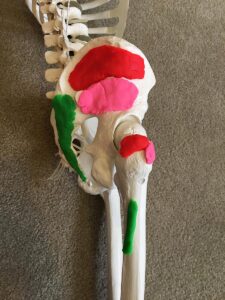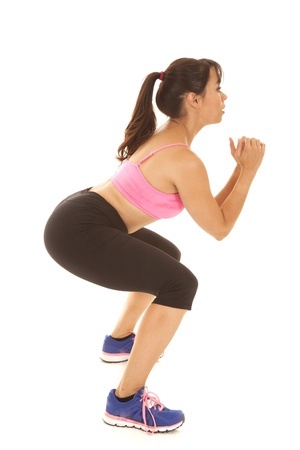Everybody knows the “glutes” are the largest muscle in the body. BUTT…they’re not just one muscle. In total, your glutes are made up of three muscles that each have 2-3 sections. In total, you have eight glutes (nickname for gluteals).
The three glutes
Gluteus Maximus – 3
Gluteus Medius – 3
Gluteus Minimus – 2
In this article you’ll learn about gluteus maximus and how to maximize it’s role as a muscle, literally!
Gluteus Maximus Attachments
All three parts of your gluteus maximus attach into the gluteal tuberosity and Iliotibial (IT) Band, which is on the lateral (outside) part of your femur bone at the superior (top) part. The gluteus maximus diverts to three different bones on the hip.

The second section goes to the sacruum.
The third section attaches to the coccyx.
These three different destinations give the gluteus maximus many options for movement.
In this photo of Andy the Skeleton, the green play-doh represents the attachment sites for the gluteus maximus (all destinations). Imagine the muscle fibers running from one side to the other, creating a bridge.
Gluteus Maximus Function
You can memorize the actions of a muscle, but what’s even better is to understand muscle function. Know the attachments and the actions are revealed!
Remember…
- Muscles contract (shorten) when lengthened to keep the bones together.
- Muscles also contract (shorten) to move bones when signaled by the brain.
Find the attachments on your own body using your fingers to locate the bony landmarks you see in the photo. Enhance your body awareness by getting familiar with the location of the muscle on yourself. Move your hip into abduction (to the side) or extension (backward) to feel the attachments contract into your fingers.
What motions would cause the muscle to shorten OR lengthen?
Gluteus Maximus Movements
- Extension. When you flex your hip while walking, biking or squatting, the glute max creates hip extension to bring the bones back together.
- Abduction. As your hip extends it naturally abducts (moves away from midline) slightly. You can choose to abduct it further from a standing or side-lying position. Remember to slightly extend (bring the leg back) to call the full attention of this muscle.
- External rotation. This is another natural component of hip extension. Humans usually have more external rotation than internal rotation at the hip, which makes sense that there’s this large muscle to help with it.
Gluteus Maximus Exercises
You might be familiar with some of these, but now you can make the most of them by focusing on the attachments of gluteus maximus as you perform the motions.
Squats. Glute max isn’t the only muscle involved with this motion, but it’s a major player. The hip has to extend, abduct and externally rotate to do stand up from a squat. *Think about the attachments as you move slowly.
- Stair Climbing. Every time you flex your hip to step up, the glute max gets stretched (lengthened) and wants to shorten, meaning it’s working/contracting. It’s similar to a squat motion, but with one leg at a time and looks different. *Place your hand on the greater trochanter and feel the muscle contracting under your fingers.
- Swimming. As you flutter kick your legs the hip is extending, abducting and externally rotating. *Focusing on the glute max during this movement can give you more power since the glute max fibers are short and dense as compared to other hip extensors like the hamstrings.
- Donkey Kicks. On all fours, extend your hip up toward the ceiling. Be careful not to arch your back too much. Go slow so you can monitor and isolate glute max. *This is a great muscle mass building exercise when done slow and controlled.
Connect to the Gluteus Maximus
When you exercise, think about the attachments of the muscle. Visualize it shortening and lengthening. Do this by going more slowly through the motions. When you exercise mindlessly and quick, your body diverts to using the muscles it’s used to recruiting. Everybody has different motor patterns based upon their structure and the movement habits they have.
Being more mindful about movement is a win-win. It builds stronger muscles and reduces the risk of injury.
Check out NFPT’s Online Anatomy Course to get more connected with your muscles and refresh anatomy knowledge.
References:
Abrahams, P.H. et al. 2003. McMinn’s Color Atlas of Human Anatomy. London: Elseiver.
Muscolino, Joseph E. 2004. Musculoskeletal Anatomy Coloring Book. Philadelphia, PA: Mosby, Inc.

 Squats. Glute max isn’t the only muscle involved with this motion, but it’s a major player. The hip has to extend, abduct and externally rotate to do stand up from a squat. *Think about the attachments as you move slowly.
Squats. Glute max isn’t the only muscle involved with this motion, but it’s a major player. The hip has to extend, abduct and externally rotate to do stand up from a squat. *Think about the attachments as you move slowly.

